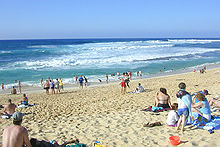Beach: Difference between revisions
mNo edit summary |
|||
| Line 2: | Line 2: | ||
[[Image:90_mile_beach02.jpg|thumb|90 mile beach Australia]] |
[[Image:90_mile_beach02.jpg|thumb|90 mile beach Australia]] |
||
[[Image:Palmtreebeach.jpg|thumb|A view from above of [[Waikiki Beach]]]] |
[[Image:Palmtreebeach.jpg|thumb|A view from above of [[Waikiki Beach]]]] |
||
[[Image:tamandare.jpg|thumb|A view from the rocks at [[Tamandaré]] Beach in Brazil]] |
|||
A '''beach''' or '''strand''' is a [[geology|geological]] formation consisting of loose [[Rock (geology)|rock]] particles such as [[sand]], [[gravel]], [[shingle]], [[pebble]]s, [[cobble]], or even [[Animal shell|shell]] along the [[shore|shoreline]] of a body of [[water]]. |
A '''beach''' or '''strand''' is a [[geology|geological]] formation consisting of loose [[Rock (geology)|rock]] particles such as [[sand]], [[gravel]], [[shingle]], [[pebble]]s, [[cobble]], or even [[Animal shell|shell]] along the [[shore|shoreline]] of a body of [[water]]. |
||
Revision as of 23:42, 23 September 2006



A beach or strand is a geological formation consisting of loose rock particles such as sand, gravel, shingle, pebbles, cobble, or even shell along the shoreline of a body of water.
Components
Some geologists consider a beach to be just this shoreline feature of deposited material, but William Bascom (1980) has argued that a beach is the entire system of sand set in motion by waves to a depth of ten meters (30+ feet) or more off ocean coasts. Submerged, longshore bars are therefore also part of the beach. In the Bascom approach, beaches can be viewed as either:
- small systems in which the rock material moves onshore, offshore, or alongshore by the forces of waves and currents; or
- geological units of considerable size.
The former are described in detail below; the larger geological units are discussed elsewhere under bars. Both types can be viewed as "beaches."
There are several conspicuous parts to a beach, all of which relate to the processes that form and shape it. The part mostly above water (depending upon tide), and more or less actively influenced by the waves at some point in the tide, is termed the beach berm. The berm is the deposit of material comprising the active shoreline. The berm has a crest (top) and a face — the latter being the slope leading down towards the water from the crest. At the very bottom of the face, there may be a trough, and further seaward one or more longshore bars: slightly raised, underwater embankments formed where the waves first start to break.
The sand deposit may extend well inland from the berm crest, where there may be evidence of one or more older crests (the storm beach) resulting from very large storm waves and beyond the influence of the normal waves. At some point the influence of the waves (even storm waves) on the material comprising the beach stops, and if the particles are small enough (that is, are sand), winds shape the feature. Where wind is the force distributing the grains inland, the deposit behind the beach becomes a dune.
The line between beach and dune is difficult to define in the field. Over any significant period of time, sand is always being exchanged between them. The drift line (the high point of material deposited by waves) is one potential demarcation. This would be the point at which significant wind movement of sand could occur, since the normal waves do not wet the sand beyond this area. However, the drift line is likely to move inland under assault by storm waves.
How beaches are formed

Beaches are deposition landforms, and are the result of wave action by which waves or currents move sand or other loose sediments of which the beach is made as these particles are held in suspension. Alternatively, sand may be moved by saltation (a bouncing movement of large particles). Beach materials come from erosion of rocks offshore, as well as from headland erosion and slumping producing deposits of scree. A coral reef offshore is a significant source of sand particles.
The shape of a beach depends on whether or not the waves are constructive or destructive, and whether the material is sand or shingle. Constructive waves move material up the beach while destructive waves move the material down the beach. On sandy beaches, the backwash of the waves removes material forming a gently sloping beach. On shingle beaches the swash is dissipated because the large particle size allows percolation, so the backwash is not very powerful, and the beach remains steep. Cusps and horns form where incoming waves divide, depositing sand as horns and scouring out sand to form cusps. This forms the uneven face on some sand shorelines.
There are several beaches which are claimed to be the "World's longest", including Cox's Bazar, Bangladesh (120kms), Fraser Island beach, 90 Mile Beach in Australia and 90 Mile Beach in New Zealand and Long Beach, Washington (which is about 30km). Wasaga Beach, Ontario on Georgian Bay claims to have the world's longest freshwater beach.
Beaches and recreation



Beaches have long been a popular attraction for tourism and recreation. Especially popular are seaside resorts and large white sand beaches. Residents and tourists alike use beaches as a place for leisure and sport. The relatively soft formation of sand is comfortable to sit or lie on, and entering and exiting the water is far easier across a sand beach than a rocky shore. The waves present at beaches add to the enjoyment and make the sport of body surfing and related activities possible. One of the many attractions of a sand beach, especially for children, is playing with the sand, building sand castles and other constructs.
Towels and mats are typical beach "furniture". In the Victorian era, many popular beach resorts were equipped with bathing machines because even the all-covering beachwear of the period was considered immodest. This social standard still prevails in some Muslim countries. At the other extreme are nude beaches, where no swimwear of any kind is compulsory.
A walk along the beach is also popular, including a long walk in the case of a long beach, for example from one seaside resort to the next. It is typically done near the shore line, where the sand is wet and therefore more convenient to walk on. One may or may not walk with the feet in the water, and this may also alternate with the waves
In more than thirty countries in Europe, South Africa, New Zealand, Canada, South America and the Caribbean, the best recreational beaches are awarded Blue Flag status, based on such criteria as water quality and safety provision. Subsequent loss of this status can have a severe effect on tourism revenues.
Due to their heavy use, beaches have often become dumping grounds for waste.
Artificial beaches
Some beaches are artificial; they are either permanent or temporary (For examples see Monaco, Paris, Rotterdam, Hong Kong and Singapore).
The soothing qualities of a beach and the pleasant environment offered to the beachgoer are replicated in artificial beaches, such as "beach style" pools with zero-depth entry and wave pools that recreate the natural waves pounding upon a beach. In a zero-depth entry pool, the bottom surface slopes gradually from above water down to depth. Another approach involves so-called urban beaches, a form of public park becoming common in large cities. Urban beaches attempt to mimic natural beaches with fountains that imitate surf and mask city noises, and in some cases can be used as a play park.
Beach nourishment involves pumping sand onto beaches to improve their health. Beach nourishment is common for major beach cities around the world; however the beaches that have been nourished can still appear quite natural and often many visitors are unaware of the works undertaken to support the health of the beach. Such beaches are often not recognised as artificial.
A concept of IENCE has been devised to describe investment into the capacity of natural environments. IENCE is Investment to Enhance the Natural Capacity of the Environment and includes things like beach nourishment of natural beaches to enhance recreational enjoyment and snow machines that extend ski seasons for areas with an existing snow economy developed upon a natural snowy mountain. As the name implies IENCE is not quite mainstream natural science as its goal is to artificially invest into an environment's capacity to support anthropogenic economic activity. An artificial reef designed to enhance wave quality for surfing is another example of IENCE. The Surfrider Foundation has debated the merits of artificial reefs with members torn between their desire to support natural coastal environments and opportunities to enhance the quality of surfing waves. Similar debates surround Beach nourishment and Snow cannon in sensitive environments.
Sounds of the beach

Beaches are noted for their sometimes serene stillness and the rhythmic sound made by waves crashing upon the sand. To experience, listen to this sound file sound recording (1.00MB) made on a South Carolina beach at night.
Beaches as habitat

A beach is an unstable environment which exposes plants and animals to harsh conditions. Some small animals burrow into the sand and feed on material deposited by the waves. Crabs, insects and shorebirds feed on these beach dwellers. The endangered Piping Plover and some tern species rely on beaches for nesting. Sea turtles also lay their eggs on ocean beaches. Seagrasses and other beach plants grow on undisturbed areas of the beach and dunes.
See also

- List of beaches
- Beach cricket
- Beach volleyball
- Coast
- Dune buggy
- Nude beach
- Pier
- Shore
- Surfing
- Urban beach
Reference
- Bascom, W. 1980. Waves and Beaches. Anchor Press/Doubleday, Garden City, New York. 366 p.
